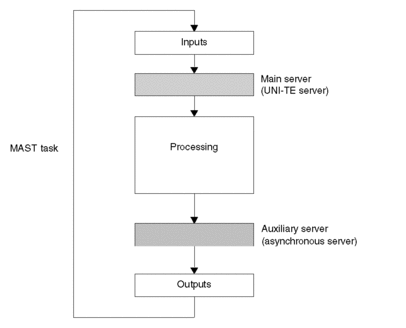At a Glance
The server function can be used to respond to requests from client devices.
The TSX 57 35• and PCX 57 35• processors provide two request servers:
a main server (recommended for requests of less than 256 bytes)
an auxiliary server (recommended for requests of up to 1024 bytes)
Both of these servers can be activated simultaneously.
Illustration
The following diagram shows the requests sent to the servers in the PLC cycle:

Main Server
This server corresponds to port 0 (UNI-TE server). It is activated at the start of the PLC's MAST cycle.
The response time of the client PLC depends on the cycle time of the server PLC. This can be used to process up to 4 simultaneous requests per PLC cycle.
All UNI-TE requests are supported. The size of the request must be less than 256 bytes.
This entity can be addressed at the topological address SYS or {network.station}SYS.
Auxiliary Server
This server corresponds to port 7 (asynchronous server). It is activated only for periodical tasks at the end of the PLC cycle, after the MAST task has been processed whilst awaiting the start of the next cycle.
The start of the next, higher priority cycle could interrupt a request in progress. Access to this server is therefore reserved for applications requiring no consistency in their read/write data.
The application response time will essentially depend on the PLC cycle time. The size of the request may be up to 1024 bytes. It cannot be accessed from a communication function; the server processes object (bit or word) READ/WRITE requests, etc.


